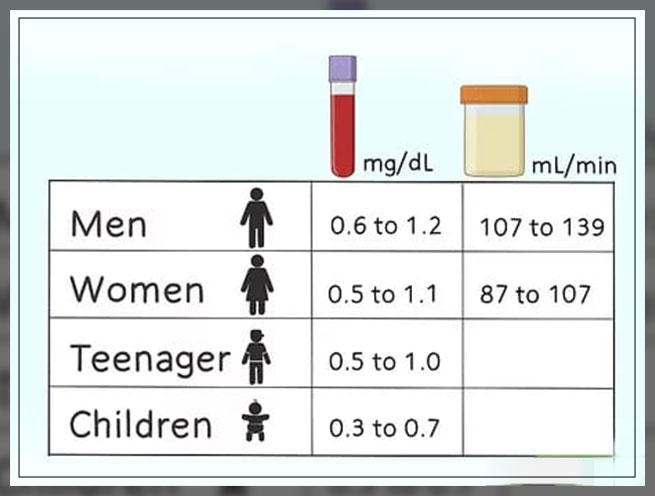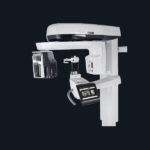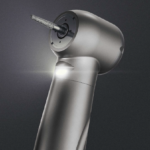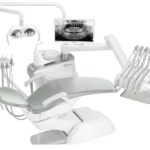
A creatinine test is a measure of how well the kidneys of a person are performing their job of filtering waste from the blood.
Creatinine is a chemical compound left over from the energy-producing process in the muscles of the human body.
Healthy kidneys tend to filter it out of the blood.
Moreover, a certain amount of creatinine exits the body as a waste product in urine.
The measurement of creatinine in the blood or urine test can help provide clues to help the doctor find how well the kidneys are working.
Keep on reading to learn more about creatinine test, their purpose, procedure, and results.
Creatinine Test
A creatinine test helps to measure the level of creatinine in the blood.
Creatinine is a waste product that forms when creatine breaks down. Creatine is a substance that is found in the muscles of the human body.
It is important to note that creatinine levels in the blood can provide information to the doctor about how well the kidneys are working.
Each kidney has millions of small blood-filtering units called nephrons.
These nephrons constantly filter blood through a very tiny cluster of blood vessels: glomeruli.

Moreover, these structures filter waste products, excess water, and other impurities out of the blood.
The toxins are stored in the bladder and then removed during urination.
Creatinine is one of the substances the kidney normally eliminates from the body.
Doctors measure the level of creatinine in the blood to check kidney function.
However, high levels of creatinine can indicate that there is damage to the kidneys and are not working.
Creatinine tests to check levels of creatinine, are often performed along with a number of other laboratory tests.
These include blood urea nitrogen, a BUN test, and a basic metabolic panel, BMP or comprehensive metabolic panel, CMP.
Furthermore, the doctor can order these tests during routine physical exams to help diagnose creatin diseases and to check any problems with the kidney function of a person.
Learn more about Blood Test: All You Need to Know here.
Why is a Creatinine test Done?
The doctor may order a creatinine test to assess the creatinine levels if a person shows signs of kidney disease.
These symptoms include:
- fatigue and trouble sleeping
- a loss of appetite
- swelling in the face, wrists, ankles, or abdomen
- lower back pain near the kidneys
- changes in urine output and frequency
- high blood pressure
- nausea
- vomiting
Conditions related to Kidney Problems
Kidney problems can be related to a number of other diseases or conditions.
These include the following:
Glomerulonephritis is an inflammation of the glomeruli due to damage.
Pyelonephritis is a bacterial infection of the kidneys.
Prostate disease like an enlarged prostate.
Blockage of the Urinary tract can be due to kidney stones.

Decrease in blood flow to the kidneys which can occur due to congestive heart failure, diabetes, or dehydration.
The death of kidney cells as a result of drug abuse.
Streptococcal infections like post-streptococcal glomerulonephritis.
Aminoglycoside medications like gentamicin, Garamycin, and Gentsasol can also cause kidney damage in some people.
Therefore, if a patient is taking this type of medication, the doctor may order regular creatinine tests to make sure the kidneys remain healthy.
Preparing for the Test
A creatinine blood test does not require much preparation.
Fasting is not necessary and the patient can and should eat and drink the same as they usually do to get an accurate result.
However, the patient needs to inform their doctor about any prescription or over-the-counter, OTC medication they are currently taking.
This is because some drugs can increase creatinine levels without causing kidney damage and interfering with the results of the patient.
Therefore, the patient should let the doctor know if there are taking:
- cimetidine, Tagamet, Tagamet HB
- nonsteroidal anti-inflammatory drugs, NSAIDs like aspirin, Bayer, or iburophen, Advil Midol
- chemotherapy drugs
- cephalosporin antibiotics like cephalexin, Keflex and cefuroxime, Ceftin
The doctor may also ask the patient to stop taking these medications or adjust the dosage before the test.
They will also consider this when interpreting the test results of a patient.
Learn more about CBC Blood Test: What they Show here.
What to Expect During the Creatinine Test?
It is important to note that the creatinine blood test is a simple test that requires the removal of a small sample of blood.
A healthcare provider will first ask the patient to pull up the sleeve so that their arm is exposed.
Then they will sterilize the injection site with an antiseptic and then tie a band around the arm of the patient.
This will make the vein swell with blood which allows them to find the vein more easily.
Once they find the vein, they will insert a needle into it to collect the blood.
In most cases, a vein on the inside of the elbow is used.

The patient may feel a slight prick when the healthcare provider inserts a needle, however, the test itself is not painful and has no higher risk.
After the healthcare provider removes the needle, they will put the bandage over the puncture wound.
Moreover, a creatinine blood test is a low-risk procedure.
However, there are some minor risks. These include:
- bruising
- pain
- infection
- fainting at the site of blood
- dizziness or vertigo
- soreness or redness at the puncture site
Once the healthcare provider draws enough blood, they will send it to the laboratory for analysis.
The doctor will give the results to the patient within a few days of testing.
Interpreting the Results
Creatinine is measured in milligrams per deciliter, mg/dL.
People who are more muscular tend to have higher creatinine levels and the results can also vary depending on age and gender.
However, in most cases, the normal creatinine levels range from 0.9 to 1.3 mg/dL in men and 0.6 to 1.1 mg/dL in women who are 18 to 60 years of age.
While normal levels are roughly the same for people over 60.
High serum creatinine levels in the blood tend to indicate that the kidneys are not functioning properly.

The serum creatinine levels may be slightly elevated or higher due to the following:
- a blocked urinary tract
- a high-protein diet
- dehydration
- kidney problems like kidney damage or infection
- reduction in blood flow to the kidneys due to shock, congestive heart failure, or complications of diabetes
However, if the creatinine is truly elevated for a patient, and it is from acute or chronic kidney injury, the level will not decrease until the problem is resolved.
If it is temporary or falsely elevated due to factors like dehydration, a very high-protein diet, or supplement usage, then reversal of these conditions can help lower the level.
Moreover, a person receiving dialysis will also have lower levels after treatment.
It is uncommon to have low levels of creatinine.
However, this can occur as a result of certain conditions that cause a decrease in muscle mass.
There is often not any cause for concern.
Other Measurements and Results
Some other results are:
The measure of serum creatinine may also help to estimate how quickly the kidneys filter blood or the glomerular filtration rate.
Due to the variability in serum creatinine from one person to another, it is important to note that GFR may provide a more accurate reading of kidney function.
The formula for calculating GFR takes into account the serum creatinine count and other factors like the age and sex of the person.
A GFR score below 60 indicates kidney disease.
However, the range of scores below 60 can help to monitor treatment and disease progression.
Creatinine Clearance Test
It is a measure of how well the kidneys filter creatinine out of the bloodstream for excretion in urine.
Moreover, creatinine clearance is determined from a measurement of creatinine in a 24-hour urine sample and from a serum sample taken during the same time period.
However, doctors can also use shorter periods for urine samples.
Creatinine clearance is in milliliters of creatinine per minute per body surface area, mL/min/BSA.
The range for aged ages 19 to 75 is 77 to 160 mL/min/BSA.
The typical range, by age for women, is:
- 18 to 29 years: 78 to 161 mL/min/BSA
- 30 to 39 years: 72 to 154 mL/min/BSA
- 40 to 49 years: 67 to 146 mL/min/BSA
- 50 to 59 years: 62 to 139 mL/min/BSA
- 60 to 72 years: 56- to 131 mL/min/BSA
Standard measures have not been determined for older adults.
Results lower than the typical range for the age group may be a sign of poor kidney function or a condition that affects blood flow to the kidneys.
Albumin/Creatinine Ratio
Another interpretation of urine creatine count is the albumin/creatinine ratio.
Albumin is a protein in the blood and healthy kidneys do not filter it out of the blood, so there should be little to no albumin found in the urine.
Moreover, the albumin/creatinine ratio shows how much albumin is in a urine sample relative to how much creatinine there is.
The results are in milligrams mg of albumin for every gram, g of creatinine.
Results indicating a healthy kidney are:
- For adult men, less than 17 mg/g
- For adult women, less than 25 mg/g
- However, a higher than-typical range can be a sign of kidney disease.
The result may indicate a complication of diabetes: diabetic nephropathy, or diabetic kidney disease.
Learn more about Kidney Dialysis, Types, Working, Procedure, and More here.
What happens after the test results?
It is important to note among normal and normal ranges are unique to vary among labs due to the use of some unique measurements or testing different samples.
The patient should always meet with the doctor to discuss the test results in more detail.
They will be able to tell the patient if they need more testing and if any treatment is required.




